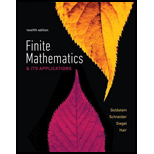
Concept explainers
Solutions can be found the section exercises.
Decide whether or not each of the given annuities is an ordinary annuity—-that is, the type of annuity considered in this section. If so, identify n, i, and R, and calculate the present value or the future value, whichever is appropriate.
You make a deposit at 9% interest compounded monthly into a fund that pays you $1 at the end of each month for 5 years.
Trending nowThis is a popular solution!

Chapter 10 Solutions
Finite Mathematics & Its Applications (12th Edition)
Additional Math Textbook Solutions
Finite Mathematics for Business, Economics, Life Sciences and Social Sciences
Pathways To Math Literacy (looseleaf)
Elementary Statistics: A Step By Step Approach
College Algebra Essentials (5th Edition)
APPLIED STAT.IN BUS.+ECONOMICS
College Algebra (7th Edition)
- Q3. The distribution for the working lifetime of light bulbs, manufactured in a company, is found to be normally distributed with a mean of 1450 hours and a standard deviation of 60 hours. a) In this distribution, find the life time of a lightbulb whose z-score is -1.8? b) Which percentage of lightbulbs have life time less than 1400 hours? c) Which percentage of lightbulbs have life time greater than 1500 hours? d) Which percentage of lightbulbs have life time between 1420 to 1500 hours?arrow_forwardQ4. Considering the following two normal distributions A and B, which statement (or statements) is correct? a) Mode of the distribution A is larger than that of distribution B. b) SD of the distribution B is larger than that of distribution A. c) Mean of the distribution A is smaller than that of distribution B. d) A data item with z-score of -1 falls between 20 to 30 in distribution A. e) A data item with z-score of +1 falls between 10 to 20 in distribution B. A 0 10 20 30 40 40 50 60 00 10 70 B 80 90 100arrow_forwardQ1. A traffic camera recorded number of red cars going through the intersection at 16th Ave N and Centre St. each day over 7 days was: 32 30 24 30 36 38 27 a) Calculate the mean, mode, range and median of the data set above. c) Calculate the standard deviation of this data set. Sarrow_forward
- Q2. Government of Canada is designing Registered Retirement Saving Plans (RRSP) for Canadians. According to statistics Canada, the life expectancy in Canada is 86 years with standard deviation of 4.8 years. a) Find the z-score of a person who is 90 years old? b) Find the age of a person whose z-score is -1.4? c) What percent of people age higher than 80? d) What percent of people age less than 83? e) What percent of people age between 85 and 88?arrow_forwardSafari File Edit View History Bookmarks Window Help Ο Ω OV O mA 0 mW ర Fri Apr 4 1 222 tv A F9 F10 DII 4 F6 F7 F8 7 29 8 00 W E R T Y U S D பட 9 O G H J K E F11 + 11 F12 O P } [arrow_forwardSo confused. Step by step instructions pleasearrow_forward
- b pleasearrow_forward(b) Let I[y] be a functional of y(x) defined by [[y] = √(x²y' + 2xyy' + 2xy + y²) dr, subject to boundary conditions y(0) = 0, y(1) = 1. State the Euler-Lagrange equation for finding extreme values of I [y] for this prob- lem. Explain why the function y(x) = x is an extremal, and for this function, show that I = 2. Without doing further calculations, give the values of I for the functions y(x) = x² and y(x) = x³.arrow_forwardPlease use mathematical induction to prove thisarrow_forward
- In simplest terms, Sketch the graph of the parabola. Then, determine its equation. opens downward, vertex is (- 4, 7), passes through point (0, - 39)arrow_forwardIn simplest way, For each quadratic relation, find the zeros and the maximum or minimum. a) y = x 2 + 16 x + 39 b) y = 5 x2 - 50 x - 120arrow_forwardIn simplest terms and step by step Write each quadratic relation in standard form, then fi nd the zeros. y = - 4( x + 6)2 + 36arrow_forward
 Algebra and Trigonometry (MindTap Course List)AlgebraISBN:9781305071742Author:James Stewart, Lothar Redlin, Saleem WatsonPublisher:Cengage Learning
Algebra and Trigonometry (MindTap Course List)AlgebraISBN:9781305071742Author:James Stewart, Lothar Redlin, Saleem WatsonPublisher:Cengage Learning College AlgebraAlgebraISBN:9781305115545Author:James Stewart, Lothar Redlin, Saleem WatsonPublisher:Cengage Learning
College AlgebraAlgebraISBN:9781305115545Author:James Stewart, Lothar Redlin, Saleem WatsonPublisher:Cengage Learning
- Algebra & Trigonometry with Analytic GeometryAlgebraISBN:9781133382119Author:SwokowskiPublisher:Cengage



